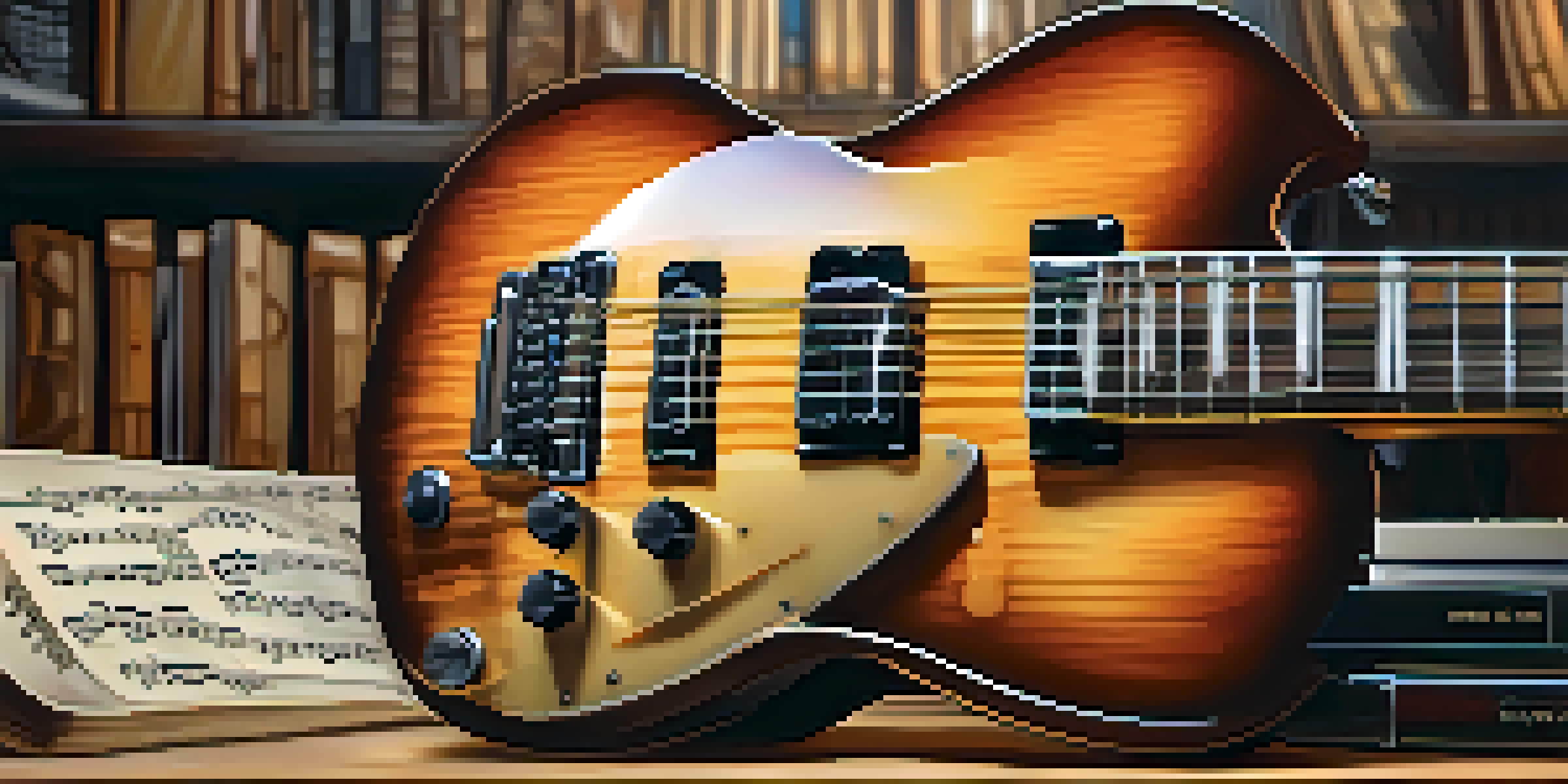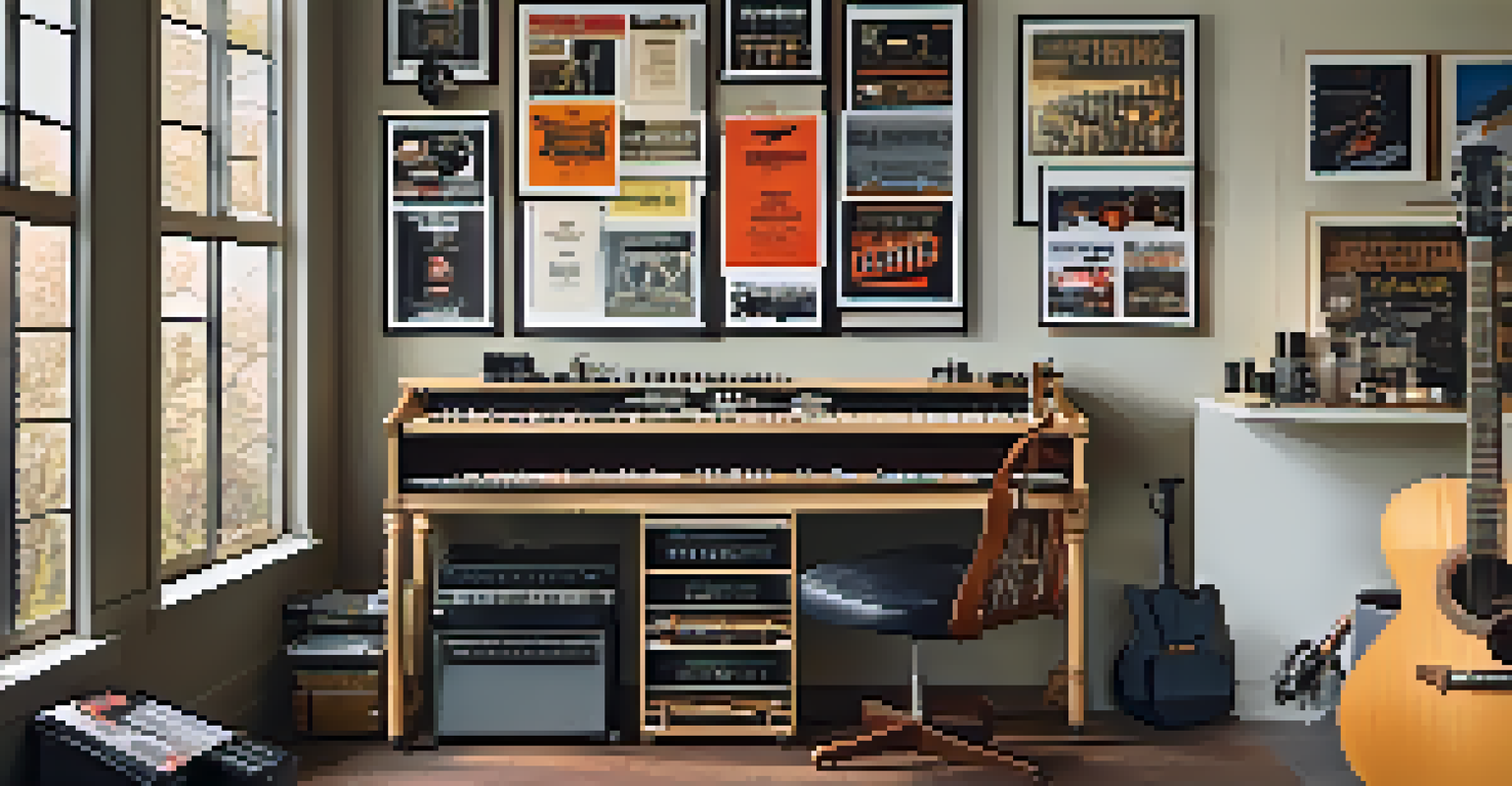Guitar Setup for Different Playing Styles: A Tailored Approach

Understanding the Basics of Guitar Setup
Setting up your guitar is essential to achieving the best sound and playability. This process involves adjusting various components like the action, neck relief, and intonation. Each of these elements contributes to how your guitar feels and sounds when you play.
A guitar is more than a collection of wood and steel. It's a reflection of who you are as a musician.
For example, if you have high action, it can make pressing down on the strings feel like a workout, whereas low action might create buzzing sounds. Understanding these basics allows you to tailor your guitar to your specific needs and preferences. A well-set-up guitar can enhance your playing experience significantly.
Whether you're a beginner or a seasoned player, mastering the fundamentals of guitar setup is the first step toward a personalized instrument. So, let’s dive deeper into how these adjustments can cater to different playing styles.
The Setup for Strumming Styles
Strumming styles, often associated with genres like folk or pop, require a setup that facilitates quick and fluid movements. For strummers, a lower action setup is typically preferred, as it allows for easier chord transitions. This makes it simpler to strum without excessive finger pressure.

Additionally, the neck relief should be minimal to avoid the strings being too far from the fretboard. This way, you can achieve a bright, crisp sound without worrying about the strings buzzing against the frets. A well-adjusted pickup height can also help capture the full resonance of your strumming.
Guitar Setup Enhances Playability
Adjusting components like action and neck relief can significantly improve how your guitar feels and sounds.
Ultimately, a tailored setup for strumming enhances your rhythm and consistency, allowing your playing to flow smoothly, which is crucial for engaging performances.
Optimizing Your Guitar for Fingerstyle Playing
Fingerstyle playing emphasizes precision and nuance, requiring a setup that allows for fine control over dynamics. A higher action setup might be more suitable for fingerstyle players, as it offers a bit of room to pluck the strings without interference. This setup helps in achieving a more pronounced sound, particularly in the bass strings.
The guitar is a miniature orchestra in itself.
Moreover, the neck relief should be adjusted to provide a balance between playability and tone. A slight bow in the neck can enable a smoother playing experience, especially when executing complex fingerpicking patterns. The pickup settings can also be adjusted to capture the subtleties of fingerstyle techniques.
In essence, a tailored setup for fingerstyle playing not only enhances sound quality but also supports the intricate techniques that define this expressive style.
Electric Guitar Setup for Lead Playing
Lead guitarists often focus on solos and intricate melodies, requiring a setup that allows for quick finger movement and a clear tonal response. A lower action setup is generally favored for lead playing, facilitating faster licks and bends. This adjustment helps in achieving a fluid playing style without excessive strain.
Additionally, the neck should have a slight relief to prevent fret buzz during rapid playing. Setting the pickup height correctly can also ensure that solos cut through the mix, providing the clarity needed for expressive playing. This setup allows for dynamic control, essential for lead guitar work.
Tailored Setup for Playing Styles
Different playing styles, such as strumming or fingerstyle, require specific setups to optimize performance and sound.
In short, an optimized electric guitar setup for lead playing can significantly enhance your ability to express yourself through solos and melodies.
Setting Up for Rhythm Guitar Playing
Rhythm guitarists provide the backbone of a band, making it essential to have a setup that supports solid chord playing and consistent strumming. A moderate action height is often ideal, striking a balance between playability and tonal depth. This ensures that you can play for long periods without fatigue while maintaining a rich sound.
The neck relief should be adjusted to accommodate consistent chord voicings without buzzing, allowing for clean, articulate playing. Pickup settings should also be optimized to capture the fullness of strummed chords while avoiding muddiness. This ensures that your rhythm playing has both presence and clarity.
Ultimately, a well-tailored setup for rhythm guitar enhances your ability to anchor the musical ensemble, making your contributions more impactful.
The Role of Strings in Guitar Setup
Choosing the right strings is a crucial aspect of your guitar setup that directly influences your playing style. Different gauges and materials can significantly affect the feel and sound of your guitar. For instance, lighter gauge strings are often easier to play and bend, making them ideal for lead and fingerstyle players.
Conversely, heavier gauge strings provide more volume and sustain, which can be beneficial for rhythm players who drive the band forward. The choice of string material—such as nickel-plated steel or pure nickel—also impacts tone, with some offering a brighter sound while others provide a warmer tone.
Regular Maintenance is Crucial
Consistent upkeep of your guitar setup ensures optimal performance and accommodates your evolving playing style.
In summary, selecting the right strings tailored to your playing style is essential for optimizing your guitar setup and achieving your desired sound.
Adjusting Electronics for Different Styles
The electronics of your guitar, including pickups and wiring, play a significant role in shaping your overall tone. Different playing styles may require different pickup configurations to get the best sound. For example, single-coil pickups are favored by many blues and rock players for their bright, clear tone, while humbuckers provide a thicker, warmer sound suitable for heavier genres.
Adjusting the height of your pickups can also help tailor your sound to your playing style. For instance, raising the pickups closer to the strings can increase output and clarity, which is beneficial for lead playing. Conversely, lowering them can soften the attack, which might be more suitable for rhythm players.

By understanding how to adjust your guitar's electronics, you can ensure that your setup complements your playing style, enhancing your musical expression.
Maintaining Your Guitar Setup for Optimal Performance
Keeping your guitar in top shape is essential for maintaining the benefits of your tailored setup. Regular maintenance, such as cleaning the fretboard, changing strings, and checking intonation, will help ensure consistent performance. A neglected guitar can lead to issues like fret buzz or tuning instability, which can hinder your playing experience.
It's also important to periodically reassess your setup based on your evolving playing style. As you grow and experiment with different genres, your preferences may change, calling for adjustments to your guitar. Keeping notes on what works best for you can help guide future setups.
In essence, maintaining your guitar setup not only preserves its playability but also allows you to continue growing as a musician, ensuring that your instrument truly reflects your unique style.